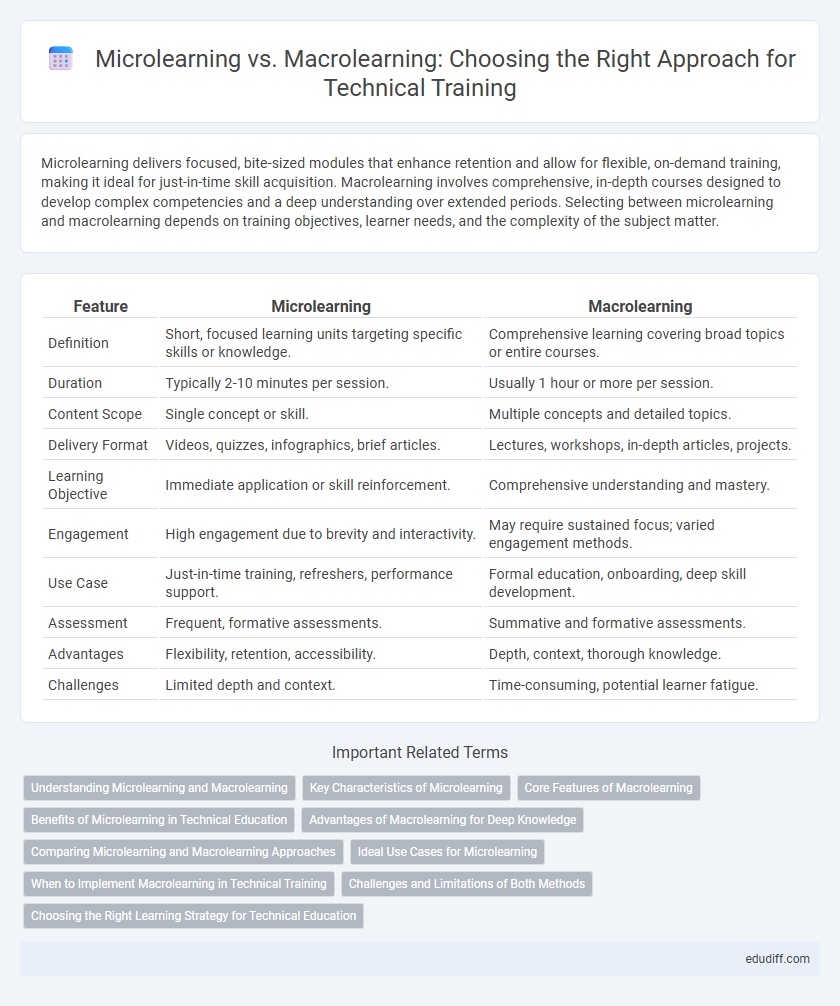Microlearning delivers focused, bite-sized modules that enhance retention and allow for flexible, on-demand training, making it ideal for just-in-time skill acquisition. Macrolearning involves comprehensive, in-depth courses designed to develop complex competencies and a deep understanding over extended periods. Selecting between microlearning and macrolearning depends on training objectives, learner needs, and the complexity of the subject matter.
Table of Comparison
| Feature | Microlearning | Macrolearning |
|---|---|---|
| Definition | Short, focused learning units targeting specific skills or knowledge. | Comprehensive learning covering broad topics or entire courses. |
| Duration | Typically 2-10 minutes per session. | Usually 1 hour or more per session. |
| Content Scope | Single concept or skill. | Multiple concepts and detailed topics. |
| Delivery Format | Videos, quizzes, infographics, brief articles. | Lectures, workshops, in-depth articles, projects. |
| Learning Objective | Immediate application or skill reinforcement. | Comprehensive understanding and mastery. |
| Engagement | High engagement due to brevity and interactivity. | May require sustained focus; varied engagement methods. |
| Use Case | Just-in-time training, refreshers, performance support. | Formal education, onboarding, deep skill development. |
| Assessment | Frequent, formative assessments. | Summative and formative assessments. |
| Advantages | Flexibility, retention, accessibility. | Depth, context, thorough knowledge. |
| Challenges | Limited depth and context. | Time-consuming, potential learner fatigue. |
Understanding Microlearning and Macrolearning
Microlearning delivers concise, focused content chunks designed to enhance retention and facilitate just-in-time training, making it ideal for skill-specific updates and fast-paced environments. Macrolearning offers comprehensive, in-depth instruction over extended periods, aimed at building foundational knowledge and complex competencies critical for mastery in technical fields. Both strategies optimize learning efficiency by aligning content scope and duration with learners' cognitive load and professional objectives.
Key Characteristics of Microlearning
Microlearning delivers concise, focused content in short segments, typically lasting between two to ten minutes, designed to enhance retention and engagement. It emphasizes just-in-time learning, allowing learners to access targeted information on-demand, which supports skill acquisition and immediate application. Key characteristics include modularity, accessibility via multiple devices, and interactive elements like quizzes and simulations to reinforce knowledge efficiently.
Core Features of Macrolearning
Macrolearning emphasizes comprehensive, in-depth content delivery designed to facilitate mastery of complex subjects through extended learning sessions and structured curriculum paths. It typically incorporates diverse instructional methods such as lectures, case studies, and collaborative projects to promote critical thinking and long-term retention. The core features include integrated assessments, learner progression tracking, and extensive multimedia resources to support a cohesive and immersive educational experience.
Benefits of Microlearning in Technical Education
Microlearning enhances technical education by delivering concise, focused content that facilitates rapid skill acquisition and retention, minimizing cognitive overload. Its bite-sized modules fit seamlessly into busy schedules, promoting continuous learning and immediate application of complex technical concepts. This approach also supports adaptive learning technologies, enabling personalized training pathways that improve learner engagement and performance in technical fields.
Advantages of Macrolearning for Deep Knowledge
Macrolearning offers comprehensive coverage essential for in-depth understanding, enabling learners to connect complex concepts across a broader context. Extended learning sessions facilitate critical thinking and the development of expertise by reinforcing material over time. This approach supports mastery and retention, making it ideal for subjects requiring deep knowledge integration and application.
Comparing Microlearning and Macrolearning Approaches
Microlearning delivers focused, bite-sized content ideal for quick knowledge acquisition and reinforcement, enhancing retention through spaced repetition and frequent engagement. Macrolearning encompasses comprehensive, in-depth training modules designed for mastery of complex subjects over extended periods, promoting deeper understanding and skill development. Choosing between microlearning and macrolearning depends on learning objectives, content complexity, and desired learner engagement levels.
Ideal Use Cases for Microlearning
Microlearning is ideal for skill-based training, just-in-time learning, and reinforcing knowledge through short, focused modules that fit into busy schedules. It excels in onboarding new employees, compliance training, and updating staff on software tools or procedures where quick comprehension is critical. This approach reduces cognitive load and enhances retention by delivering content in digestible chunks tailored to specific learning objectives.
When to Implement Macrolearning in Technical Training
Macrolearning is best implemented in technical training when comprehensive understanding and mastery of complex systems or processes are required, such as software development lifecycle or network architecture. It supports in-depth knowledge acquisition over extended periods, enabling learners to integrate and apply multifaceted technical concepts effectively. This approach is essential for roles demanding high-level problem-solving skills and strategic thinking in technical environments.
Challenges and Limitations of Both Methods
Microlearning faces challenges such as limited depth and difficulty in conveying complex concepts due to its brief format, which can hinder comprehensive understanding. Macrolearning, while thorough, often encounters issues with learner engagement and time constraints, making it difficult for participants to sustain focus over extended sessions. Both methods require careful design to balance content retention with learner motivation and practical time management.
Choosing the Right Learning Strategy for Technical Education
Microlearning delivers focused, bite-sized technical content ideal for reinforcing specific skills, while macrolearning provides comprehensive, in-depth training essential for mastering complex systems and concepts. Selecting the right strategy depends on the learner's objectives, with microlearning enhancing quick retention and just-in-time application, and macrolearning supporting thorough understanding and long-term knowledge development. Technical education programs thrive by integrating both approaches, optimizing engagement and expertise acquisition based on the curriculum's depth and learner needs.
Microlearning vs Macrolearning Infographic

 edudiff.com
edudiff.com